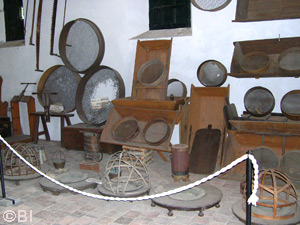Museum of The Ancient Local Civilization
Masseria Lombardo
 Masseria Lombardo is located in the Cuntarati district, a few kilometers from Bronte, along the Simeto valley, immersed in a green landscape characterized by olive groves, pistachio groves and sciara (lava soil). Masseria Lombardo is located in the Cuntarati district, a few kilometers from Bronte, along the Simeto valley, immersed in a green landscape characterized by olive groves, pistachio groves and sciara (lava soil). It is easily reachable from Bronte by going down towards the Saragoddio crossroads from the Sciarotta district; after a few kilometers a large wrought iron gate that leads into a "basolato lavico" (lava paving) avenue characterizes the entrance. Upon entering, after about 300 meters, you reach a small square where, isolated in the surrounding greenery, the structure of the Masseria is located: two buildings joined by a courtyard and the lookout tower, located in a prominent position over the entire area. The Masseria, also known as the Museum of Ancient Local Civilization, is a testimony to the first human settlements in the area, since 500 AD.
Tradition has it that the building, built by the Arabs, was inhabited for several centuries by monks who used it as a paper mill, wool processing and leather tannery (it is still possible to see the collection tanks, terracotta channels and remains of wooden structures). The discovery of the paper mill occurred by chance in the early seventies. It had, in fact, been partially overwhelmed by the lava flow of 1651. Some ruins remained, the perimeter walls and a watchtower that suggested that the structure had been fortified to protect it from external attacks.
 Perhaps, with the other in the Ricchisgia district, it represents one of the first paper mills existing in the Mediterranean basin. Perhaps, with the other in the Ricchisgia district, it represents one of the first paper mills existing in the Mediterranean basin.
The wood from the forests of the area constituted the raw material while the water came from an underground spring of the nearby Monte Barca. The Arabs, masters of hydraulic techniques, had created an ingenious system of underground channels of which there are still clear traces today. In the years following the discovery, the owner, Nunzio Lombardo, worked hard with his own means to restore the paper mill, maintaining its original layout, both to protect it from atmospheric agents and to enhance its own aspects, as well as archaeological and cultural. In the same rooms and in other annexes, he then collected, with patient research, tools and instruments, used in everyday life at the beginning of the last century and which constitute the ethno-anthropological museum (or of the ancient local civilization), where objects, furnishings, work tools used by the peasant population between 1700 and 1900 are exhibited.
 The Museum of the ancient local civilization exhibits ancient household goods, work tools, clothes and various furnishings used from past centuries to today. The Museum of the ancient local civilization exhibits ancient household goods, work tools, clothes and various furnishings used from past centuries to today.
It reconstructs (with precision and breadth of detail) the domestic environments of the agricultural world or the small workshop of the artisans (the blacksmith, the farrier, the shoemaker, the carpenter). A collection made up of small things, plows and tools of local craftsmanship, clothes and furniture, irons, typewriters, ancient kitchens and countless other finds. Simple evidence (worn by use) that arouse curiosity, respect and emotion; countless finds that are historical testimonies, fascinating symbols of everyday life. All this has been catalogued with infinite care and passion according to the themes of domestic, artisanal, agricultural work and the beginning of the industrial era. The restoration project of the old buildings, the research and recovery of the tools and implements of local agriculture and craftsmanship, the restoration of the ancient structures in lava stone and sandstone, as well as the parallel project of safeguarding and recovery of the zoological, botanical and agricultural heritage, began around 1975 thanks to the brilliant initiative of a private individual (Nunzio Lombardo) who, it can be said, dedicated, even among a thousand difficulties and ostracisms of all kinds, his life to the realization of the work.
 At the cost of personal sacrifices, Nunzio Lombardo has safeguarded from dispersion, precious memories, artifacts and objects of significant documentary value, organizing them in his "Masseria" with an exhibition perspective that has favored productive and artisanal activities, as well as the forms of work typical of the fields and sheep farming. At the cost of personal sacrifices, Nunzio Lombardo has safeguarded from dispersion, precious memories, artifacts and objects of significant documentary value, organizing them in his "Masseria" with an exhibition perspective that has favored productive and artisanal activities, as well as the forms of work typical of the fields and sheep farming. Among the ancient buildings, the Paper Mill, the Furnace, the eighteenth-century Masseria and the suggestive Watch Tower have been renovated.
Furthermore, ancient finds from the settlements in the Bronte area have been brought to light, restored and preserved, making them available to tourists and scholars, thus giving the Sicilian cultural heritage rare testimonies of our local civilization. It should be emphasized that the Museum of the "Masseria Lombardo" was also conceived as a message to present and future generations, a call to respect and enhance Sicilian traditions and the environment.
(Nino Liuzzo, November 2002)
|